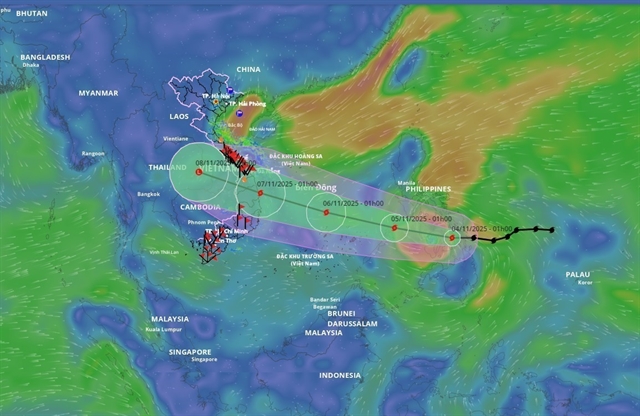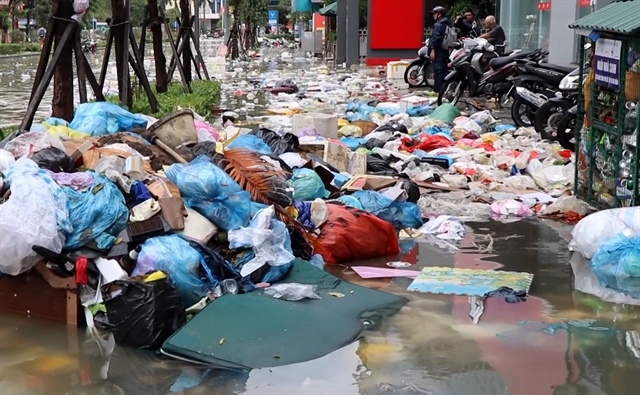 Environment
Environment

Hạ Long Bay, a designated UNESCO World Heritage site and one of Việt Nam’s top tourist draws, is reportedly suffering extensive violations that threaten to destroy its famed natural beauty, but local authorities have questioned the accuracy of some of the reports.
 |
| The Sửng Sốt or Surprise Grotto in Hạ Long Bay. — VNA/VNS Photo Minh Đức |
QUẢNG NINH – Hạ Long Bay, a designated UNESCO World Heritage site and one of Việt Nam’s top tourist draws, is suffering extensive violations that threaten to destroy its famed natural beauty, the media reported.
Electrocuted to death
On a 10-minute boat ride from the Hạ Long fish market to the bay, dozens of boats can be spotted fishing by electrocution – a dangerous method categorically prohibited.
Local fishermen who adhere to the traditional fishing method provide a helpful tip to easily identify those electro-fishing – a bundle of cords and ropes hanging from the stern into the water. In addition, the boat moves slowly and drags a huge net to collect the electrocuted fish.
“From Hạ Long to Cẩm Phả City, there are a few thousand boats outfitted with inverters that constantly roam the waters,” Đặng Văn Mẫu, a local fisherman, told Tiền Phong Newspaper (Vanguard).
In the bay area, an electro-fishing boat can be seen every few hundred metres, causing a depletion of natural resources that is increasingly evident.
“An electric output of 1,500-2,000 watts shoots through the waters, sparing almost no sea creatures within its 20m radius, babies or mature fish, prawns or microorganisms. They are really exhausting the ocean’s resources, and all we traditional fishermen can do is just sit idly by and watch the sea dying,” Nguyễn Văn Chiến said.
Concerned traditional fishermen have filed numerous reports, and authorities have conducted inspections and administered penalties to violators, but the sheer number of such fishermen makes the task daunting.
“With dwindling seafood resources, catches using traditional nets amount to just one fifth compared to previous times, so more are resorting to utilise electro-fishing to catch hundreds of kilograms of fish without much effort,” a local fisherman said. The difficulty is compounded by the fact that most fishing boats operate in Hạ Long Bay without a licence number affixed to their side as legally required.
Local residents say some fishermen even go so far as to use dynamite to catch fish.
“It’s winter so it’s no longer as common as in warmer weather, but the strangest thing is that no one got punished,” a fisherman from Cửa Vạn Village, said.
According to a 2013 Government decree, electro-fishing is fined by VNĐ2-5 million ($89-221), while for dynamite fishing, the penalty can reach VNĐ10-20 million ($440-880).
Local fishermen allegedly said that they’d rather pay the small fines than stop this lucrative fishing method.
Phạm Đình Huỳnh, Deputy Director of Hạ Long Bay Management Board, told Việt Nam News that the bay’s enforcement force had discovered and handled 34 violations, collecting fines of VNĐ108 million (US$4,400) just from the beginning of this year alone – considerably higher than previous years.
However, he also admitted that the management board is aware that the current fines are not much of a deterrent but its hands are tied. Since 2014, the management board and Quảng Ninh Province authorities have twice proposed a special mechanism allowing it more autonomy and flexibility, but the Government has not yet approved, saying that there cannot be separate regulations for each heritage site.
Reports on ruined caves denied
For decades now, the stalactites that lined the roofs of the limestone caves – which took thousands of years to form – have been haphazardly sawed off and sold as decorations in non bộ gardens (miniature landscapes) or in aquariums, according to some recent media reports.
“This exploitation of stalactites is quite alarming in the area under our cooperative’s jurisdiction,” Vũ Văn Hùng, deputy manager of the Hạ Long Fishing Village Cooperative, was quoted by Tiền Phong as saying.
In the Hạ Long Bay and Bái Tử Long Bay area, a number of caves were regarded as valuable tourist attractions for their beauty and curious stalactite structure and have been put under constant surveillance. On the other hand, the majority are more obscure, located on steep and rugged cliffs.
“Previously, the stalactites were cut off to use in households only. In recent years however, some ask the locals to steal these stones and are willing to buy them at a high price. The small ones can sell for a few million đồng, while the large-sized and beautiful, sparkling ones can easily fetch 100 million đồng,” Tiền Phong quoted another fisherman in Hùng Thắng Ward, Hạ Long City.
Fifteen metres into Cặp La Cave – a hot spot of stalactite theft - most stalactites are cut in half. Some stalactites lie scattered on the ground, covered in traces of dust suspectedly from the sawing off process, the newspaper reports.
In caves like Trinh Nữ (Virgin), Trống (Rooster), Tiên Ông (Fairy), the walls are defaced with indelible Chinese and Vietnamese letters left behind by ill-mannered tourists.
“These caves used to be shelters for fishermen during storms. Some stalactites were indeed taken away. It stopped when the caves were designated tourist sites. Its floors were cemented to turn them into fancy restaurants," Nguyễn Văn Thành, a senior fisherman, said.
The cave-restaurants drew the ire of the public and have since been suspended.
However, Phạm Đình Huỳnh, from the bay’s management board, has categorically denied the reports on vandalism, “There’s absolutely no exploitation of stalactites going on in the caves within the World Heritage Site of Hạ Long Bay, as falsely reported by some newspapers.”
Prior to the establishment of the management board in 1995, people might have "harvested" stalactites freely, but since then there has been constant camera surveillance, iron barriers and round-the-clock guards, putting a stop to such theft.
He also said stalactites do break off naturally, as evidenced by the accumulation of relatively new bits of rock. It’s all "part of the geological formation processes that have been active for millions of years. These tectonic activities indicate that the bay is ‘living’ and constantly changing, it will not stay static,” he explained.
“The ‘head’ of the iconic Thiên Nga (Swan) islet has broken off and fallen into the sea water. It’s heavily debated whether to recover the rock that weighs hundreds of tonnes and re-attach it, or just to leave it alone and accept nature’s course,” Huỳnh said.
The board has implemented various measures, including "moorings" that hold the stalactites in caves open to tourism, both to ensure tourists’ safety and to conserve the structure to the extent possible.
Regarding the defacement of stalactites and stalagmites, the board said the growing tourist awareness coupled with the constant surveillance have put a stop to such vandalism.
As for the "cave restaurants", these are not exactly restaurants since there’s no cooking there; he said; dishes are prepared on cruise ships and brought to the caves for the passengers to enjoy. The flooring is wood ply that can easily be removed and poses little harm to the caves. In any case, following the criticism, this tourist activity has been stopped, he added.
The management is also working closely with local residents and businesses who operate in the bay area to get timely information on any kind of violations. – VNS




.jpg)